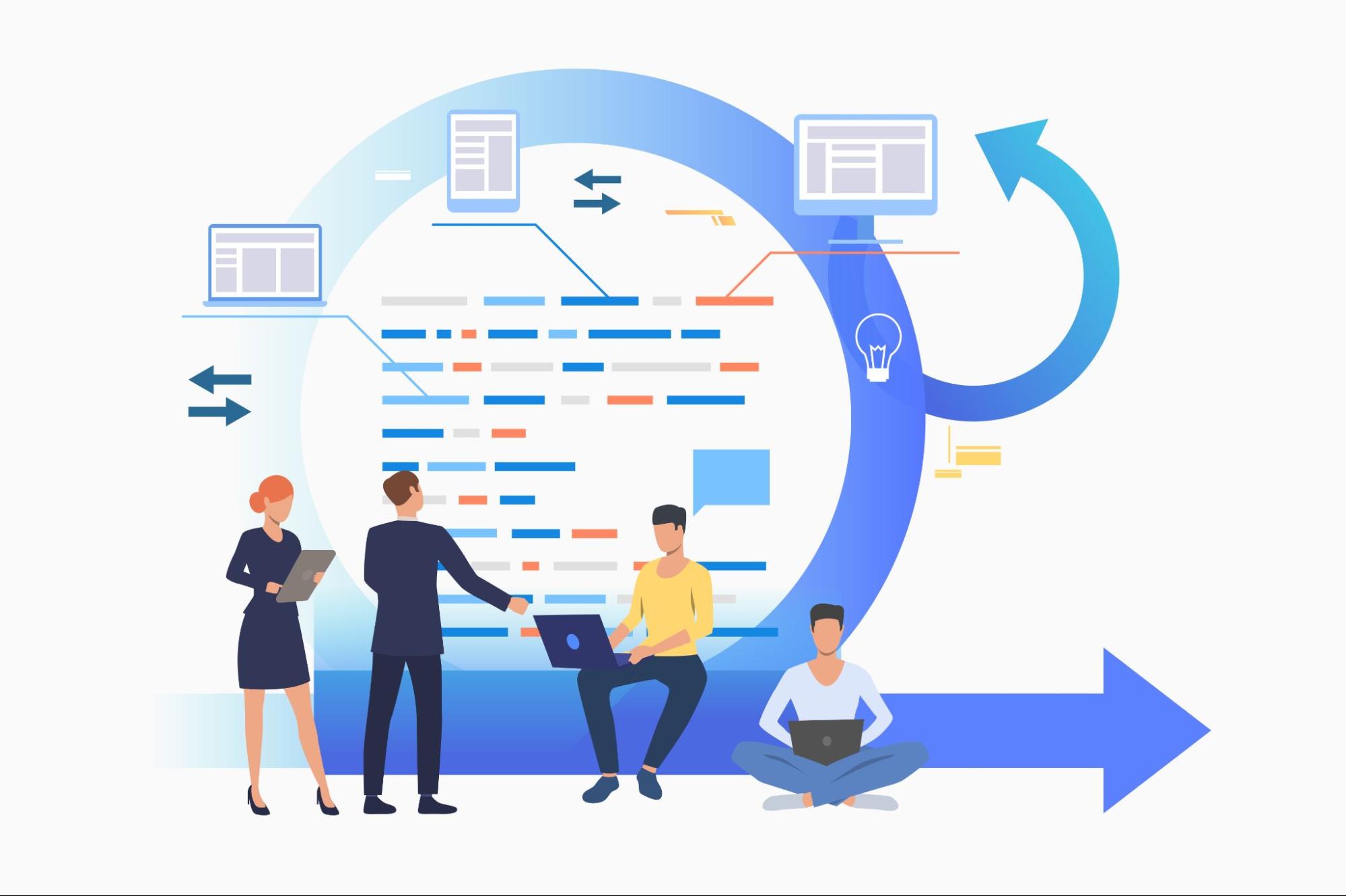Project management offers various frameworks, but some, like waterfall, lack effectiveness for software teams. Agile, however, addresses changing priorities by breaking projects into phases for continuous improvement. Its applicability extends beyond software, empowering diverse teams for success. If you're delving into Agile, you're on the right track.
What is the Agile methodology?
Agile methodology is a dynamic project management framework that breaks projects into iterative phases called sprints. Unlike traditional approaches, Agile prioritizes adaptability, making it ideal for software teams and various other domains. After each sprint, teams reflect on progress and adjust strategies, fostering continuous improvement and meeting evolving customer needs. Agile's versatility extends its effectiveness to diverse projects, emphasizing collaboration and innovation within a dynamic landscape.
What is the Agile Manifesto?

The Agile Manifesto, crafted in February 2001 by 17 software developers seeking an alternative to traditional product development processes, is centred on four core values and 12 principles for Agile software development.
What Are The 4 Pillars Of Agile?
As mentioned above, these values form the foundation of Agile project management:
-
Individuals over processes and tools: Agile prioritizes team collaboration and synergy over rigid processes and tools, emphasizing the importance of collective effort.
-
Working software over comprehensive documentation: Agile teams focus on delivering functional software, valuing practical outcomes over extensive documentation.
-
Customer collaboration over contract negotiation: Customers play a pivotal role in Agile, guiding software development direction. Collaboration with customers takes precedence over intricate contract negotiations.
-
Responding to change over following a plan: Agile thrives on adaptability, enabling teams to pivot swiftly in response to evolving requirements. Flexibility reigns supreme over adhering strictly to predefined plans.
What Are The 12 Agile Principles?

In Agile methodology, the four foundational values serve as the sturdy pillars supporting a structure of 12 guiding principles. These principles, akin to rooms in a house, provide adaptable frameworks for teams to tailor to their needs:
-
Customer satisfaction through continuous improvement: Regular updates keep customers engaged, leading to satisfaction and loyalty, which is vital for sustained revenue streams.
-
Embrace changing requirements: Agile thrives on adaptability, accommodating evolving needs even late in the project cycle to ensure relevance and success.
-
Frequent value delivery: Consistently delivering value to stakeholders fosters trust and reduces churn, reinforcing the project's impact and significance.
-
Break project silos for collaboration: Agile emphasizes teamwork, encouraging cross-functional collaboration to leverage diverse expertise and enhance outcomes.
-
Empower motivated individuals: Agile teams thrive when members are engaged and committed, driving progress and innovation towards shared goals.
-
Face-to-face communication: Prioritizing direct communication, especially in distributed teams, fosters clarity and alignment, which are vital for project success.
-
Working software as a progress metric: Functional software is paramount, serving as the ultimate measure of progress and success within Agile projects.
-
Maintain sustainable pace: Agile promotes a balanced workflow, avoiding burnout by ensuring a sustainable rhythm throughout the project lifecycle.
-
Continuous pursuit of excellence: Consistent delivery of high-quality work enables teams to build momentum and drive efficiency in future iterations.
-
Simplicity for effectiveness: Agile encourages simplicity over complexity, favouring straightforward solutions to intricate problems for streamlined progress.
-
Self-organizing teams for value generation: Proactive teams drive value creation, leveraging autonomy and accountability to maximize productivity and impact.
-
Regular reflection and adaptation: Retrospective meetings enable teams to review performance, identify areas for improvement, and adapt strategies for enhanced effectiveness.
Benefits Of The Agile Development Methodology

Agile development methodology offers numerous benefits. It is particularly prevalent in application and software development due to the dynamic nature of the field. Unlike linear approaches like the waterfall model, Agile thrives on adaptability, enabling teams to swiftly adjust strategies without disrupting project momentum.
The agility inherent in Agile methodologies allows for rapid response to changing requirements, a crucial advantage in the ever-evolving landscape of software development. This flexibility ensures that teams can navigate shifting priorities and emerging challenges with ease.
Moreover, Agile fosters collaborative teamwork, emphasizing face-to-face communication and the breakdown of project silos. Despite technological advancements enabling remote work, the value of direct interaction remains paramount, promoting synergy and collective effort among team members.
Another key benefit is Agile's focus on customer needs. With the ability to solicit and incorporate feedback promptly, Agile teams can tailor products and features to closely align with customer preferences. This customer-centric approach not only enhances satisfaction but also ensures that the product remains relevant and competitive in the market.
Exploring Agile Methodologies
1. Kanban
Visualizing Workflow Kanban offers a visual approach to Agile, utilizing online Kanban board tools to map out tasks' progress in the development process. Tasks are represented as cards, moving through stages delineated by columns. This method facilitates easy identification of bottlenecks and provides a clear visualization of work in progress.
2. Scrum
Sprinting Towards Success Scrum, a widely adopted Agile methodology, particularly suits small teams. Central to Scrum is the role of a Scrum master, responsible for eliminating obstacles hindering the team's progress. Daily meetings ensure alignment on active tasks and allow for swift resolution of any impediments.
Key Scrum Events
-
Sprint Planning: Sets the stage for the sprint, defining what will be delivered and how.
-
Sprint Retrospective: Provides an opportunity for reflection, leveraging insights from previous sprints to enhance future iterations.
3. Extreme Programming (XP)
Cultivating Effective Collaboration Extreme Programming (XP), tailored for software development, embodies values that foster team synergy and efficiency. Its core values—Communication, Simplicity, Feedback, Courage, and Respect—lay the foundation for collaborative excellence.
XP emphasizes regular releases and iterations, aligning closely with customer needs. It offers a technical approach, focusing on efficient execution and rapid response to customer requests, making it ideal for teams requiring swift adaptation and delivery.
4. Adaptive Project Framework (APF)
APF, or Adaptive Project Management (APM), recognizes the inevitability of unknown variables in projects. This is particularly prevalent in IT projects where traditional management techniques fall short. Central to APF is the acknowledgement that project resources can fluctuate unpredictably, necessitating a focus on the resources available rather than those desired. This adaptive approach enables teams to navigate shifting budgets, timelines, and team compositions with agility and resilience.
5. Extreme Project Management (XPM)
XPM is tailored to manage highly complex projects fraught with uncertainty. This dynamic approach thrives on constant adaptation as teams navigate through spontaneous changes and swiftly alter strategies to align with evolving project requirements. With an emphasis on flexibility, XPM structures sprint to be short, facilitating frequent adjustments, trial-and-error problem-solving, and iterative self-correction.
6. Adaptive Software Development (ASD)
ASD, an Agile methodology, empowers teams to swiftly respond to changing project demands. Continuous adaptation lies at the core of ASD, with its phases—speculate, collaborate, and learn—fostering ongoing learning and evolution. Teams often find themselves concurrently engaged in all three phases, with their fluid, non-linear structure facilitating rapid problem identification and resolution, surpassing the capabilities of traditional project management methods.
7. Dynamic Systems Development Method (DSDM)
DSDM stands out among Agile methodologies for its comprehensive approach to the entire project lifecycle. Unlike some Agile methods, DSDM boasts a more structured and robust foundation. It unfolds in four key phases:
-
Feasibility and business study
-
Functional model or prototype iteration
-
Design and build iteration
-
Implementation
8. Feature Driven Development (FDD)
FDD merges various Agile best practices into a coherent framework. While still embracing iterative project management principles, FDD distinguishes itself by placing a strong emphasis on the specific features of the software under development. Customer input drives feature prioritization, ensuring alignment with user needs. Moreover, FDD facilitates frequent project updates, enabling swift error resolution through its constantly evolving phases.
Organize Agile Processes With Optimizory

Optimizory offers tailored solutions such as RMsis and Links Explorer to help your team implement and optimize Agile processes. Whether you're in software development or any other industry, Agile methodology can enhance flexibility and productivity. Our experts will guide you through every step, from defining project goals to sprint planning and retrospectives, ensuring seamless integration and effective project management. Let Optimizory empower your team to thrive with Agile methodologies.





